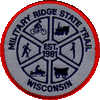Friends of military ridge trail
Home
|
Contact Us© COPYRIGHT 2024. ALL RIGHTS RESERVED.
|
Home
|
Contact Us© COPYRIGHT 2024. ALL RIGHTS RESERVED.
|
